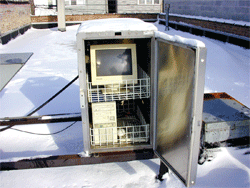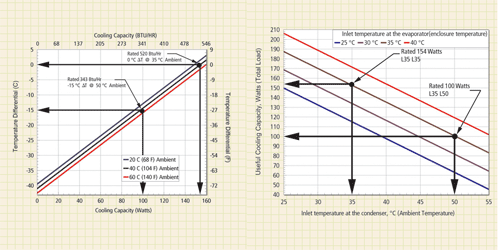Understanding ratings for thermoelectric coolers
To choose the most suitable TE system, engineers should learn how suppliers may play the ratings game
BY ANDY BRECKLIN
Thermoelectric Cooling America
Chicago, IL
http://www.thermoelectric.com
A t one time or another, every engineer must compare the rated values for components or systems. Before doing so, a wise engineer asks, “Are all of the products under consideration ‘rated’ according to accepted or even similar standards? Are they all rated under of the same conditions?”
Engineers know that any differences in how products are rated make comparison difficult, if not impossible. Fortunately, industry organizations such as ANSI, DIN, ATEX, and ASHRAE (the American Society of Heating, Refrigerating and Air-Conditioning Engineers) have, for many product categories, defined standards, conditions, and, in many cases, test procedures for determining ratings.
Reality check
Unfortunately, for many thermoelectric (TE) cooling systems, standards are not available. Thus, comparisons of the actual cooling power of the devices being reviewed can be quite confusing.
While competitive products may appear to offer similar cooling capabilities, the reality can be quite different. If critical performance variations are not identified before the TE system is applied, the system being cooled may be at risk of failure, or worse.
Because TE cooling is used in so many different applications (see Fig. 1 ), there are many different kinds of applicable ratings. Thus a manufacturer can say just about anything and—as long as they are not saying it about someone else’s product—may not be making a legally false claim.
The key to understanding actual performance isn’t so much a system’s rating as it is the conditions under which it is rated—that’s why there are organizations who carve standards in stone. And “published ratings” should not be confused with standards.

Fig. 1. Since system applications vary widely, engineers need to understand how thermoelectric-system ratings translate into real-life performance.
What’s a ‘published rating’?
According to ASHRAE, a published rating is “a statement of the assigned values of those characteristics, under stated Rating Conditions, by which a unit may be chosen to fit its application.” Note that the ASHRAE makes the point that published rating’s values need to be obtained under “stated Rating Conditions”; this aspect can easily be overlooked.
Traditionally, ratings have been used to quickly identify a product or product family which will meet certain specifications or requirements. Once identified, a particular product requires further research into its characteristics to determine if it will ideally fulfill the requirements.
But it is its rating that identifies the product as a possibility in the first place, and it’s confidence in these ratings that allows one to do so. Of course, when the published ratings of a product don’t conform to its real performance, trouble will surely ensue—which is a story of its own.
There are times when a product is rated at other than the standard rating conditions. And sometimes it is for good reasons—a product might, under special conditions, be rated to highlight its durability or superiority, or when the requirements are well out of the normal rating conditions. In these cases, the presumably gruelling conditions would be highlighted.
This special-conditions situation is not as uncommon as one might think. In such cases as these, it is considered appropriate to define those special conditions under which the rating applies. Even when there aren’t any defined standards, there is usually a tradition within the industry, and this is certainly the the case with individual TE modules.
Traditionally, TE modules have been rated at two performance points:
maximum load with no temperature differential (Qmax )
maximum temperature differential at zero load (∆Tmax ) for a specified hot-side temperature.
Usual and unusual TE ratings
A recent survey of TE module manufacturers shows they all conform to this traditional standard. Unfortunately, when it comes to assembled TE systems (which may include thermoelectric modules, heat sink, fan, and enclosure), ratings are not quite as clear-cut and standardized. The discrepancy can certainly be blamed in part on the lack of accepted standards. After all, what organization can afford to take the time and effort to write a standard for a “widget” for which there is little demand?
However, the traditional Qmax and ∆Tmax methods for rating individual modules can be adapted to complete TE systems. One of the standards most applicable to TE systems is found in DIN 3168, a well defined standard for the rating and testing of coolers for distribution boxes (enclosure air conditioners).
Of the two standard rating conditions found in DIN 3168, one, L35L35, is defined similarly to the traditional TE rating Qmax . It determines the cooling capacity needed to maintain 35C inlet temperature at the evaporator (enclosure temperature) when the inlet temperature at the condenser (ambient temperature) is also 35C.
The second condition, L35L50, could then be used in determining the traditional ∆Tmax . In this instance, the cabinet temperature would be also be 35C but the ambient would be 15C higher, or 50C. Here we’ve found that wonderful condition where traditional approaches and standards largely agree (see Fig. 2 ).
Given the availability of such a methodology, there doesn’t seem to be any reason to use another approach for rating a TE system product. However, some TE air conditioner manufacturers rate their product under conditions of 120F ambient and an enclosure rise of 20F.

Fig. 2. Traditional (left) and DIN 3168 (right) rating systems produce equivalent results. Cooling capacity needed to maintain 35°C inside a cabinet with a 35° or 50°C ambient is shown in both.
This begs the question, “Is your enclosure really being cooled if it’s 20°F above ambient?” If these rating conditions were openly stated, any engineer worthy of the title would quickly question the validity of the “rating.”
But when a rating appears to fill engineering requirements, the main concern usually becomes cost once the product spec is out of the engineer’s hands and into those of purchasing. Looking for cost savings, the purchasing agent will search for products with similar ratings and, in all likelihood, won’t examine rating conditions closely, unless specifically noted in the engineering description.
So some manufacturers may choose a different rating method, using a kind of “honest” deception to increase their business. In which case, ancient wisdom applies—caveat emptor .
Will the specified product deliver what’s needed?
To ensure your design project’s success, make certain that its real cooling needs are well understood and defined. Doing so inevitably leads to a good understanding of the cooling performance that will actually be required.
For any candidate TE system, examine how its manufacturer determines its ratings, under what conditions they are measured. If the ratings just don’t “feel” right (such as our 20°F-rise cooling condition), call it to the manufacturer’s attention.
As noted previously, there may be perfectly good reasons for determining ratings under special conditions. So ask the company’s engineers to explain their logic.
Even better, ask if them if they can convert their specification into data so that their system can be compared with competitors’ offerings on a level playing field. While you want to give their rating-approach motivation the benefit of the doubt, don’t accept confusing data.
If you, as the design engineer, decide to call for a poorly or oddly rated item in your project, be sure to identify the rating conditions that an equivalent component or system should meet to fulfill your system requirements. Define the “engineering considerations” or “conditions of acceptability” for use.
To ensure your projects success, don’t just throw your bill of material over the wall to your purchasing department. Working with the purchasing department and thinking about the next step in the product-creation process should make the purchaser’s job easierand yours too in the long run. After all, this process will make for a better, more profitable product which, in the end, is what everyone wants.
In summation, what’s needed to make a proper evaluation is
Thorough understanding of ratings,
Knowledge of available industry standards,
Analysis of test methods applied to those ratings,
Conscious effort to seek out the real data needed.
Ultimately, only by testing a cooling system in the intended application, under actual operating conditions, can you confirm or debunk performance claims once and for all. But proper evaluation will reduce the need for last-minute redesigns.
Advertisement
Learn more about Teca





